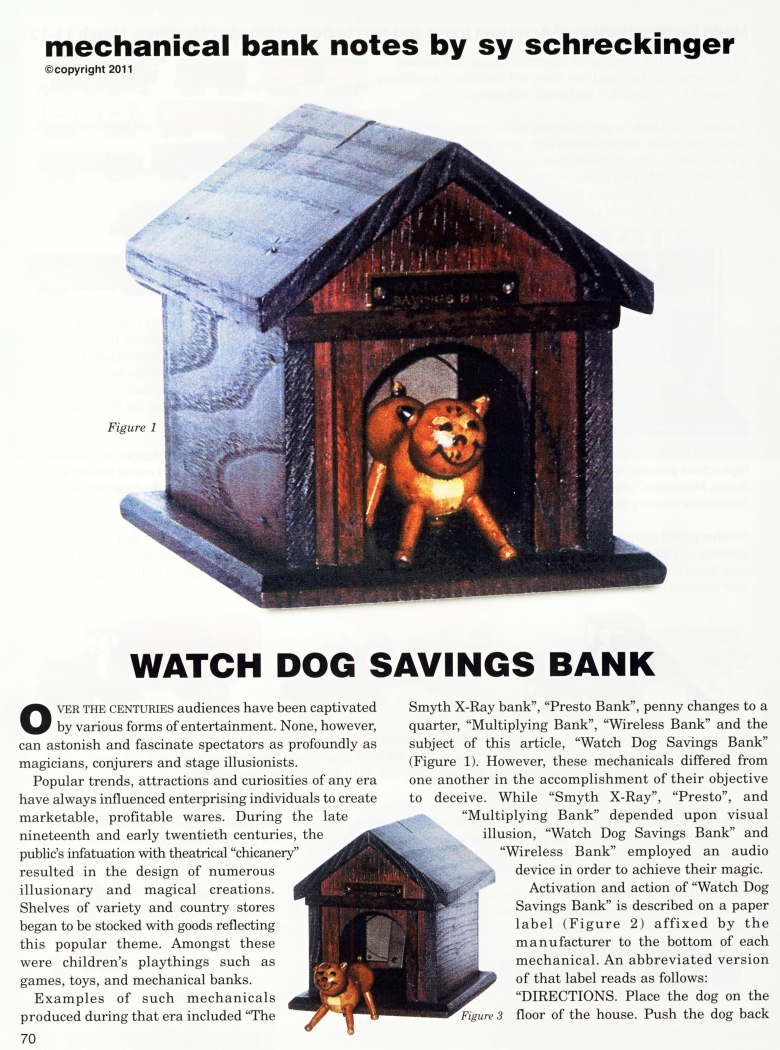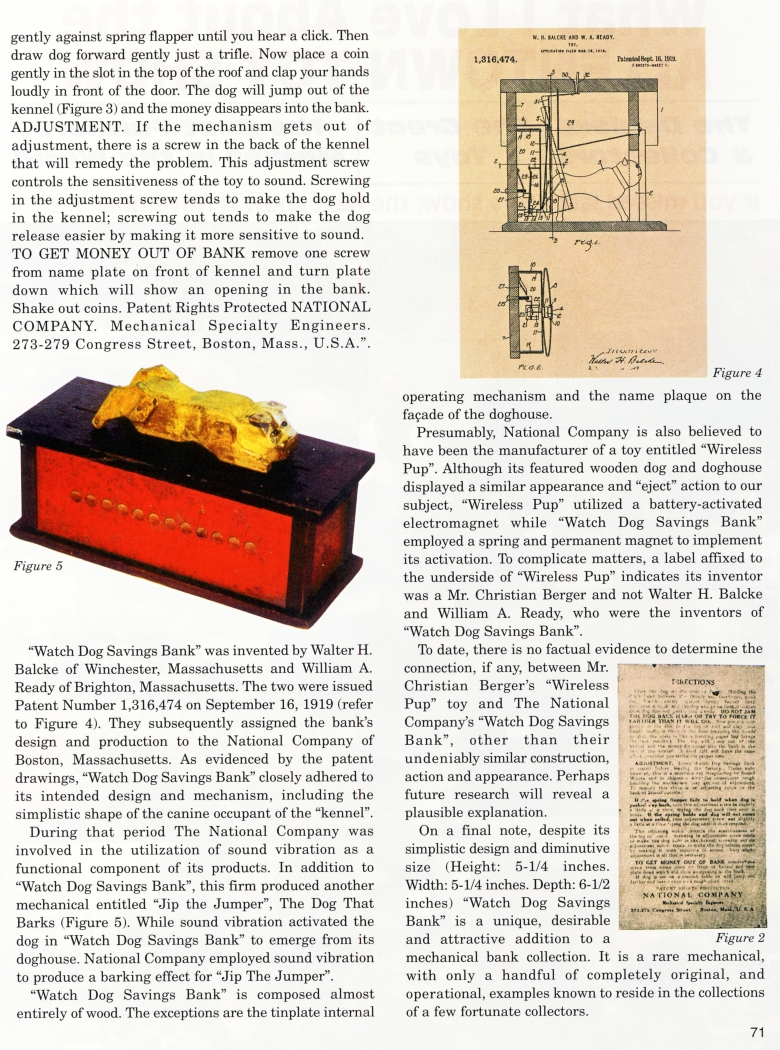|
Watch Dog Savings Bank
by Sy Schreckinger – ANTIQUE TOY WORLD Magazine – March, 2011
OVER
THE CENTURIES audiences have been captivated by various forms of
entertainment. None, however, can astonish and fascinate spectators as
profoundly as magicians, conjurers and stage illusionists.
Popular trends, attractions and curiosities of any era have always
influenced enterprising individuals to create marketable, profitable
wares. During the late nineteenth and early twentieth centuries, the
public's infatuation with theatrical "chicanery" resulted in the design
of numerous illusionary and magical creations. Shelves of variety and
country stores began to be stocked with goods reflecting this popular
theme. Amongst these were children's playthings such as games, toys, and
mechanical banks.
Examples of such mechanicals produced during that era included "The
Smyth X-Ray bank", "Presto Bank", penny changes to a
quarter, "Multiplying Bank", "Wireless Bank" and the
subject of this article, "Watch Dog Savings Bank"
(Figure 1). However, these mechanicals differed from
one another in the accomplishment of their objective
to deceive. While "Smyth X-Ray", "Presto", and
"Multiplying Bank" depended upon visual
illusion, "Watch Dog Savings Bank" and "Wireless Bank" employed an audio
device in order to achieve their magic.
Activation and action of "Watch Dog
Savings Bank" is described on a paper
label (Figure 2) affixed by the
manufacturer to the bottom of each
mechanical. An abbreviated version
of that label reads as follows:
"DIRECTIONS. Place the dog on the Figure 3 floor of the house. Push the
dog back
gently against spring flapper until you hear a click. Then draw dog
forward gently just a trifle. Now place a coin gently in the slot in the
top of the roof and clap your hands loudly in front of the door. The dog
will jump out of the kennel (Figure 3) and the money disappears into the
bank. ADJUSTMENT. If the mechanism gets out of adjustment, there is a
screw in the back of the kennel that will remedy the problem. This
adjustment screw controls the sensitiveness of the toy to sound.
Screwing in the adjustment screw tends to make the dog hold in the
kennel; screwing out tends to make the dog release easier by making it
more sensitive to sound. TO GET MONEY OUT OF BANK remove one screw from
name plate on front of kennel and turn plate down which will show an
opening in the bank. Shake out coins. Patent Rights Protected NATIONAL
COMPANY. Mechanical Specialty Engineers. 273-279 Congress Street,
Boston, Mass., U.S.A.".
"Watch Dog Savings Bank" was invented by Walter H. Balcke of Winchester,
Massachusetts and William A. Ready of Brighton, Massachusetts. The two
were issued Patent Number 1,316,474 on September 16, 1919 (refer to
Figure 4). They subsequently assigned the bank's design and production
to the National Company of Boston, Massachusetts. As evidenced by the
patent drawings, "Watch Dog Savings Bank" closely adhered to its
intended design and mechanism, including the simplistic shape of the
canine occupant of the "kennel".
During that period The National Company was involved in the utilization
of sound vibration as a functional component of its products. In
addition to "Watch Dog Savings Bank", this firm produced another
mechanical entitled "Jip the Jumper", The Dog That Barks (Figure 5).
While sound vibration activated the dog in "Watch Dog Savings Bank" to
emerge from its doghouse. National Company employed sound vibration to
produce a barking effect for "Jip The Jumper".
"Watch Dog Savings Bank" is composed almost entirely of wood. The
exceptions are the tinplate internal
operating mechanism and the name plaque on the facade of the doghouse.
Presumably, National Company is also believed to have been the
manufacturer of a toy entitled "Wireless Pup". Although its featured
wooden dog and doghouse displayed a similar appearance and "eject"
action to our subject, "Wireless Pup" utilized a battery-activated
electromagnet while "Watch Dog Savings Bank" employed a spring and
permanent magnet to implement its activation. To complicate matters, a
label affixed to the underside of "Wireless Pup" indicates its inventor
was a Mr. Christian Berger and not Walter H. Balcke and William A.
Ready, who were the inventors of "Watch Dog Savings Bank".
To date, there is no factual evidence to determine the connection, if
any, between Mr. Christian Berger's "Wireless Pup" toy and The National
Company's "Watch Dog Savings Bank", other than their undeniably similar
construction, action and appearance. Perhaps future research will reveal
a plausible explanation.
On a final note, despite its simplistic design and diminutive size
(Height: 5-1/4 inches. Width: 5-1/4 inches. Depth: 6-112 inches) "Watch
Dog Savings Bank" is a unique, desirable and attractive addition to a
mechanical bank collection. It with only a handful of completely
original, and operational, examples known to reside in the collections
of a few fortunate collectors.
|

